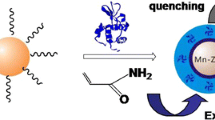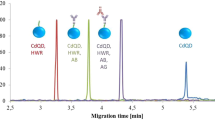Abstract
CdTe quantum dots capped with thioglycolic acid (TGA) display a strong turn-on fluorescence response if exposed to solutions of cysteine (Cys). In order to exploit this effect, a molecularly imprinted polymer (MIP) for Cys was covalently linked to the QDs via allyl mercaptan. The resulting nanomaterials (QDs, MIP-coated QDs, and nonimprint-coated QDs) were characterized by FTIR and scanning electron microscopy. The adsorption of Cys was studied in phosphate buffer (pH 7.4) with respect to equilibration times (5, 15, and 40 min, respectively), binding constants [2.98, 2.42, and 0.96 (×104 M−1)], and Langmuir isotherms (R2 = 0.9995, 0.9999, and 0.9983) in the Cys concentration range between 3.33 μM to 500 μM. The method has a detection limit of 0.85 μM (3σ, blank, for n = 10). The selectivity of the MIP-coated QDs for Cys over 19 other amino acids is similar to that of bare QDs, but MIP-QDs afford better recoveries of Cys from solutions also containing bovine serum albumin (90 %) and fetal bovine serum (97 %), respectively, when compared to the recoveries that are obtained with bare (non-imprinted) QDs (135 % and 120 %). This is probably due to the fact that the outer MIP shell largely reduces protein wrapping, dot aggregation, and matrix inclusion.

Using the turn-on fluorescence detection of cysteine template, quantum dots (QDs) conjugated with MIP via allyl mercaptan were synthesized in a one-pot polymerization and exhibited a higher binding selectivity in the presence of serum matrices compared to bare QDs and non-imprinted polymer-QDs.




Similar content being viewed by others
References
Esteve-Turrillas FA, Abad-Fuentes A (2013) Applications of quantum dots as probes in immunosensing of small-sized analytes. Biosens Bioelectron 41:12–29
Kuang H, Zhao Y, Ma W, Xu L, Wang L, Xu C (2011) Recent developments in analytical applications of quantum dots. Trends Anal Chem 30:1620–1636
Delehanty JB, Susumu K, Manthe RL, Algar WR, Medintz IL (2012) Active cellular sensing with quantum dots: transitioning from research tool to reality; a review. Anal Chim Acta 750:63–81
Ruedas-Rama MJ, Walters JD, Orte A, Hall EAH (2012) Fluorescent nanoparticles for intracellular sensing: a review. Anal Chim Acta 751:1–23
Li H, Han C, Zhang L (2008) Synthesis of cadmium selenide quantum dots modified with thiourea type ligands as fluorescent probes for iodide ions. J Mater Chem 18:4543–4548
Ruedas-Rama MJ, Hall EAH (2008) Azamacrocycle activated quantum dot for zinc ion detection. Anal Chem 80:8260–8268
Aguilera-Sigalat J, Casas-Solvas JM, Morant-Miñana MC, Vargas-Berenguel A, Galian RE, Pérez-Prieto J (2012) Quantum dot/cyclodextrin supramolecular systems based on efficient molecular recognition and their use for sensing. Chem Commun 48:2573–2575
Algarra M, Campos BB, Alonso B, Miranda MS, Martínez ÁM, Casado CM, Esteves da Silva JCG (2012) Thiolated DAB dendrimers and CdSe quantum dots nanocomposites for Cd (II) or Pb (II) sensing. Talanta 88:403–407
Li DW, Qin LX, Li Y, Nia RP, Long YT, Chen HY (2011) CdSe/ZnS quantum dot–cytochrome c bioconjugates for selective intracellular O2•– sensing. Chem Commun 47:8539–8541
Yuan Q, Lu D, Zhang X, Chen Z, Tan W (2012) Aptamer-conjugated optical nanomaterials for bioanalysis. Trends Anal Chem 39:72–86
Wulff G (2013) Forty years of molecular imprinting in synthetic polymers: origin, features and perspectives. Microchim Acta 180:1359–1370
Poma A, Turner APF, Piletsky SA (2010) Advances in the manufacture of MIP nanoparticles. Trends Biotechnol 28:629–637
Lee MH, Chen YC, Ho MH, Lin HY (2010) Otical recognition of salivary proteins by use of molecularly imprinted poly (ethylene-co-vinyl alcohol)/quantum dot composite nanoparticles. Anal Bioanal Chem 397:1457–1466
Wang HF, He Y, Ji TR, Yan XP (2009) Surface molecular imprinting on Mn-doped ZnS quantum dots for room-temperature phosphorescence optosensing of pentachlorophenol in water. Anal Chem 81:1615–1621
Ge S, Lu J, Ge L, Yan M, Yu J (2011) Development of a novel deltamethrin sensor based on molecularly imprinted silica nanospheres embedded CdTe quantum dots. Spectrochim Acta A Mol Biomol Spectrosc 79:1704–1709
Liu H, Liu D, Fang G, Liu F, Liu C, Yang Y, Wang S (2013) A novel dual-function molecularly imprinted polymer on CdTe/ZnS quantum dots for highly selective and sensitive determination of ractopamine. Anal Chim Acta 762:76–82
Zhang W, He XW, Chen Y, Li WY, Zhang YK (2012) Molecularly imprinted polymer anchored on the surface of denatured bovine serum albumin modified CdTe quantum dots as fluorescent artificial receptor for recognition of target protein. Biosens Bioelectron 31:84–89
Lin CI, Joseph AK, Chang CK, Lee YD (2004) Molecularly imprinted polymeric film on semiconductor nanoparticles: analyte detection by quantum dot photoluminescence. J Chromatogr A 1027:259–262
Stringer RC, Gangopadhyay S, Grant SA (2010) Detection of nitroaromatic explosives using a fluorescent-labeled imprinted polymer. Anal Chem 82:4015–4019
Liu H, Fang G, Li C, Pan M, Liu C, Fan C, Wang S (2012) Molecularly imprinted polymer on ionic liquid-modified CdSe/ZnS quantum dots for the highly selective and sensitive optosensing of tocopherol. J Mater Chem 19882–19887
Zhao Y, Ma Y, Li H, Wang L (2012) Correction to composite QDs@MIP nanospheres for specific recognition and direct fluorescent quantification of pesticides in aqueous media. Anal Chem 84:386–395
Diltemiz SE, Say R, Büyüktiryaki S, Hür D, Denizli A, Ersöz A (2008) Quantum dot nanocrystals having guanosine imprinted nanoshell for DNA recognition. Talanta 75:890–896
Chao MR, Chang YZ, Chen JL (2013) Hydrophilic ionic liquid-passivated CdTe quantum dots for mercury ion detection. Biosens Bioelectron 42:397–402
Zhong W, Zhang C, Gao Q, Li H (2012) Highly sensitive detection of lead (II) ion using multicolor CdTe quantum dots. Microchim Acta 176:101–107
Keane PM, Gallagher SA, Magno LM, Leising MJ, Clark IP, Greetham GM, Towrie M, Guńko YK, Kelly JM, Quinn SJ (2012) Photophysical studies of CdTe quantum dots in the presence of a zinc cationic porphyrin. Dalton Trans 41:13159–13166
Jhonsi MA, Vaishnavi E, Suganya R, Kathiravan A, Renganathan R (2011) Investigation on the photoinduced interaction between water soluble CdTe quantum dots and certain antioxidants. Adv Sci Lett 4:3490–3495
Diao XL, Xia YS, Zhang TL, Li Y, Zhu CQ (2007) Fluorescence-detecting cationic surfactants using luminescent CdTe quantum dots as probes. Anal Bioanal Chem 388:1191–1197
Adegoke O, Nyokong T (2012) A comparative study on the sensitive detection of hydroxyl radical using thiol-capped CdTe and CdTe/ZnS quantum dots. J Fluoresc 22:1513–1519
Wang Y, Zheng J, Zheng Z, Yuan C, Fu D (2009) CdTe nanocrystals as luminescent probes for detecting ATP, folic acid and l-cysteine in aqueous solution. Colloids Surf A Physicochem Eng Asp 342:102–106
Chen Y, Rosenzweig Z (2002) Luminescent CdS quantum dots as selective ion probes. Anal Chem 74:5132–5138
Poderys V, Matulionyte M, Selskis A, Rotomskis R (2011) Interaction of water-soluble CdTe quantum dots with bovine serum albumin. Nanoscale Res Lett 6:9
Huanga S, Xiaoa Q, Li R, Guana HL, Liua J, Liu XR, Hea ZK, Liu Y (2009) A simple and sensitive method for l-cysteine detection based on the fluorescence intensity increment of quantum dots. Anal Chim Acta 645:73–78
Wanga GL, Donga YM, Yang HX, Li ZJ (2011) Ultrasensitive cysteine sensing using citrate-capped CdS quantum dots. Talanta 83:943–947
Chen S, Fan Y, Yang Y, Ye LY, Long YF (2012) Determination of cysteine based on fluorescence enhancement of CdS quantum dots with Cd2+ rich surface. Chin J Anal Chem 40:173–176
Chen S, Tian J, Jiang Y, Zhao Y, Zhang J, Zhao S (2013) A one-step selective fluorescence turn-on detection of cysteine and homocysteine based on a facile CdTe/CdS quantum dots–phenanthroline system. Anal Chim Acta 787:181–188
Acknowledgments
Support for this work by the National Science Council of Taiwan under Grant no. NSC–101–2113–M–039–001–MY3 and the China Medical University under Grant no. CMU101–S–11 is gratefully acknowledged.
Author information
Authors and Affiliations
Corresponding author
Electronic supplementary material
Below is the link to the electronic supplementary material.
ESM 1
(PDF 233 kb)
Rights and permissions
About this article
Cite this article
Chao, MR., Hu, CW. & Chen, JL. Fluorescent turn-on detection of cysteine using a molecularly imprinted polyacrylate linked to allylthiol-capped CdTe quantum dots. Microchim Acta 181, 1085–1091 (2014). https://doi.org/10.1007/s00604-014-1209-6
Received:
Accepted:
Published:
Issue Date:
DOI: https://doi.org/10.1007/s00604-014-1209-6




